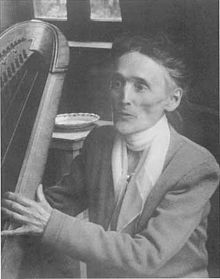Henriette Renié
Henriette Gabrielle Marie Sophie Renié (born September 18, 1875 in Paris ; † March 1, 1956 there ) was a French harpist and composer .
life and work
Henriette Renié's father worked as a painter and singer. She herself received piano lessons at an early age and, from the age of eight, harp lessons from Alphonse Hasselmans , who, after receiving a professorship at the Paris Conservatory , accepted her into his class there at the age of ten. In 1887 she completed the annual concours with a Premier Prix . At the age of thirteen, Renié was admitted - a year earlier than usual - to study harmony and composition, where they taught Charles Lenepveu and Théodore Dubois . In 1891 she received the Prix de Harmonie , in 1896 the Prix de Contrepoint, Fugue et Composition .
In 1901 she completed her own harp concerto and premiered it as a composer and interpreter with the Orchester Lamoureux under Camille Chevillard . Invitations to concerts in numerous European countries followed. Renié's harp playing subsequently prompted several composers to write new works for this instrument, including Théodor Dubois, Gabriel Pierné , Claude Debussy and Maurice Ravel .
In 1912 Hasselmans had envisaged Henriette Renié as his successor to his chair, but the conservatory management decided on Marcel Tournier . Nevertheless, Renié had numerous students, some of whom she also supported financially, including Susann McDonald , Mildred Dilling , Marcel Grandjany , Carlos Salzedo and Sally Maxwell . In 1914 she initiated the first international harp competition ( Prix or Concours Renié ), which was held again after the First World War in 1921, 1923 and 1926, but had to be discontinued for cost reasons.
Shortly before the Second World War, Renié reduced her concert activity in order to concentrate on the two-volume textbook “Méthode complète de harpe” commissioned by the Alphonse Leduc publishing house . In 1935 she received the gold medal of the Salon des Musiciens français . In 1954 she was one of the first women to become a member of the Legion of Honor (knight class). Henriette Renié remained active as an interpreter until a few months before her death.
In addition to the harp concerto in C minor (1901), compositions for harp and orchestra were composed of a "Pièce symphonique", compositions for chamber music and solo works for harp, including a "legend" based on the poem "Les Elfes" by Leconte de Lisle ( first performed in 1902, recorded on record by Renié for the Odeon label in 1926 ). Renié also transcribed numerous works for the harp ("Les classiques de la harpe", 12 books) as well as for the harp ensemble. The two-volume textbook "Méthode complète de harpe" was published in 1946.
literature
- Article in Friedrich Blume (Hrsg.): Music in history and present , 1st edition, 1949–1986.
- Jaymee Janelle Haefner: Virtuoso, Composer, and Teacher: Henriette Renie's Compositions and Transcriptions for Harp in Perspective . Diss. Indiana University, ProQuest, 2007 (therein: Brief Biography , pp. 3–14) ( abstract )
Web links
- Steven Nordstrom, David A. Day: Finding aid for the Henriette Renié (1875-1956) and Françoise des Varennes (1919-) Papers 1875-1994, Music Special Collections, Harold B. Lee Library, Brigham Young University, Provo, Utah; 2003 (therein: Biographical Sketch, pp. 3–6)
- Sheet music and audio files by Henriette Renié in the International Music Score Library Project
| personal data | |
|---|---|
| SURNAME | Renié, Henriette |
| ALTERNATIVE NAMES | Renié, Henriette Gabrielle Marie Sophie (full name) |
| BRIEF DESCRIPTION | French harpist and composer |
| DATE OF BIRTH | September 18, 1875 |
| PLACE OF BIRTH | Paris |
| DATE OF DEATH | March 1, 1956 |
| Place of death | Paris |
